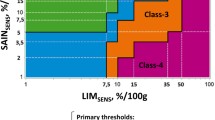Abstract
A new EU regulation on nutrition and health claims made on foods has entered into force in January 2007. The regulation provides for the use of nutrient profiles to determine which foods may bear claims but does not specify what the profiles should be or how they should be developed. Several nutrient profiling schemes have already been established. Therefore, it is necessary to develop approaches to test if the existing profiling schemes could fulfil the new regulation needs. The aim of the present study is to investigate how reference “indicator foods” derived from national dietary surveys in five different countries, are classified according to three existing nutrient profiling schemes: The UK Food Standards Agency (FSA) model, The Dutch Tripartite classification model and the US FDA model used for regulating health claims. “Indicator foods” that have been shown to be positively or negatively associated with healthy diets in adults in five EU countries were classified according to each of the three profiling schemes. The performance and effectiveness of each profiling scheme in correctly classifying the “indicator foods” were assessed using sensitivity and specificity ratios. The sensitivity and the specificity ratios of the three profiling schemes tested were relatively good. There were only small differences of performance between the three systems. A significant negative correlation between sensitivity and specificity was observed. The level of concordance between the classification of the “indicator foods” that have been selected because of being positively or negatively associated with a healthy diet and the classification by each of the three profiling methods tested was quite good. However, further improvement of the “indicator foods” approach is needed if it is to serve as a “gold standard”.

Similar content being viewed by others
References
Volatier JL, Biltoft-Jensen A, De Henauw S, Gibney MJ, Huybrechts I, McCarthy SN, O’Neill JL, Quinio C, Turrini A, Tetens I (2007) A new reference method for the validation of the profiling schemes using dietary surveys. Eur J Nutr 46(Suppl 2):29–36
Rayner M, Scarborough P, Boxer A and Stockley L (2005) Nutrient profiles: development of Final Model, December, British Heart Foundation Health Promotion Research Group. Department of Public Health, University of Oxford
Netherlands Nutrition Center (2005) Criteria for the nutritional evaluation of foods, the Netherlands tripartite classification for foods. http://www.voedingscentrum.nl
FDA (2002) Code of Federal Regulations, Title 21—Food and drugs (volume 2), Chapter I-Food and Drug Administration, Department of Health and Human Services, Part 101-Food Labeling-Table of Contents, Subpart A-General Provisions, Sec. 101.14 Health claims: general requirements and Subpart E-Specific requirements for Health Claims. U.S. Government Printing Office, Revised as of April 1
FDA (2002) Code of Federal Regulations, Title 21—Food and drugs (volume 2), Chapter I—Food and Drug Administration, Department of Health and Human Services, Part 101–Food Labeling-Table of Contents, Subpart A-General Provisions, Sec. 101.12 Reference amounts customarily consumed per eating occasion
Acknowledgments
The authors would like to thank the participants of the Workshop ‘Nutritional Characterisation of Foods: Science-based Approach to Nutrient Profiling’, 25-27 April 2006, Spain for their useful comments and discussions.
This publication was coordinated by Carina Madsen, Scientific Project Manager at ILSI Europe. This work was commissioned by the Functional Foods Task Force of the European branch of the International Life Sciences Institute (ILSI Europe). Industry members of this task force are Ajinomoto Europe, Barilla G. & R. Fratelli, BASF, Bayer CropScience BioScience, Beneo-Orafti, Beverage Partners Worldwide, Campina, Coca-Cola European Union Group, Colloïdes Naturels International, CSM, Danisco, Dow Europe, Friesland Foods, Frutarom, GlaxoSmithKline, Groupe Danone, Kellogg, Kraft Foods, Mars, McNeil Nutritionals, Monsanto Europe-Africa, Nestlé, PepsiCo International, Procter & Gamble, Raisio, Red Bull, Royal Cosun, Südzucker, Tate & Lyle Speciality Sweeteners, Unilever, Valio, Wild Flavors, Wimm-Bill-Dann Foods, Yakult Europe. For further information about ILSI Europe, please call + 32 2 771.00.14 or email info@ilsieurope.be. The opinions expressed herein are those of the authors and do not necessarily represent the views of ILSI Europe.
Disclosure The authors have no conflict of interest to declare.
Author information
Authors and Affiliations
Consortia
Rights and permissions
About this article
Cite this article
Quinio, C., Biltoft-Jensen, A., De Henauw, S. et al. Comparison of different nutrient profiling schemes to a new reference method using dietary surveys. Eur J Nutr 46 (Suppl 2), 37–46 (2007). https://doi.org/10.1007/s00394-007-2005-4
Published:
Issue Date:
DOI: https://doi.org/10.1007/s00394-007-2005-4




